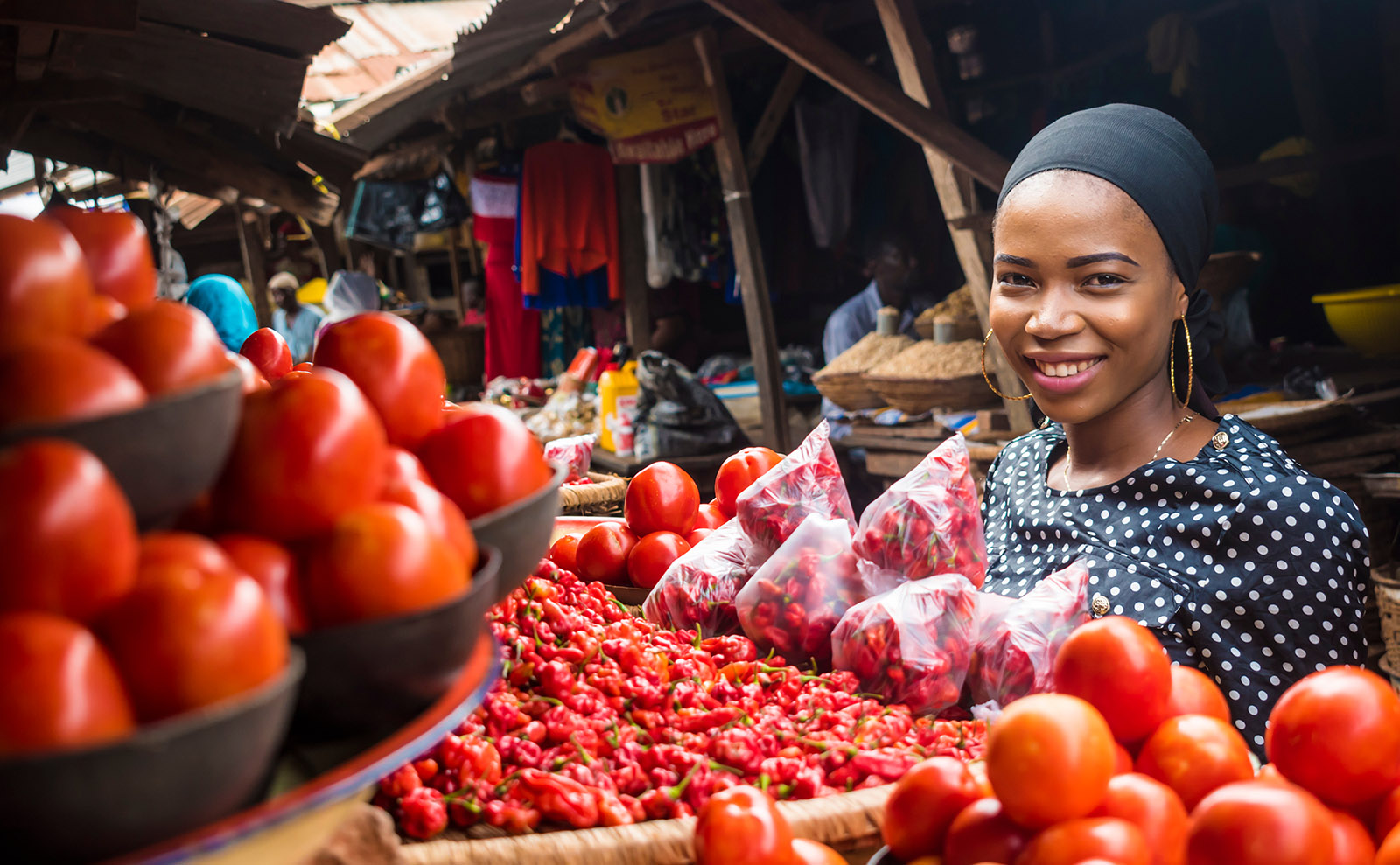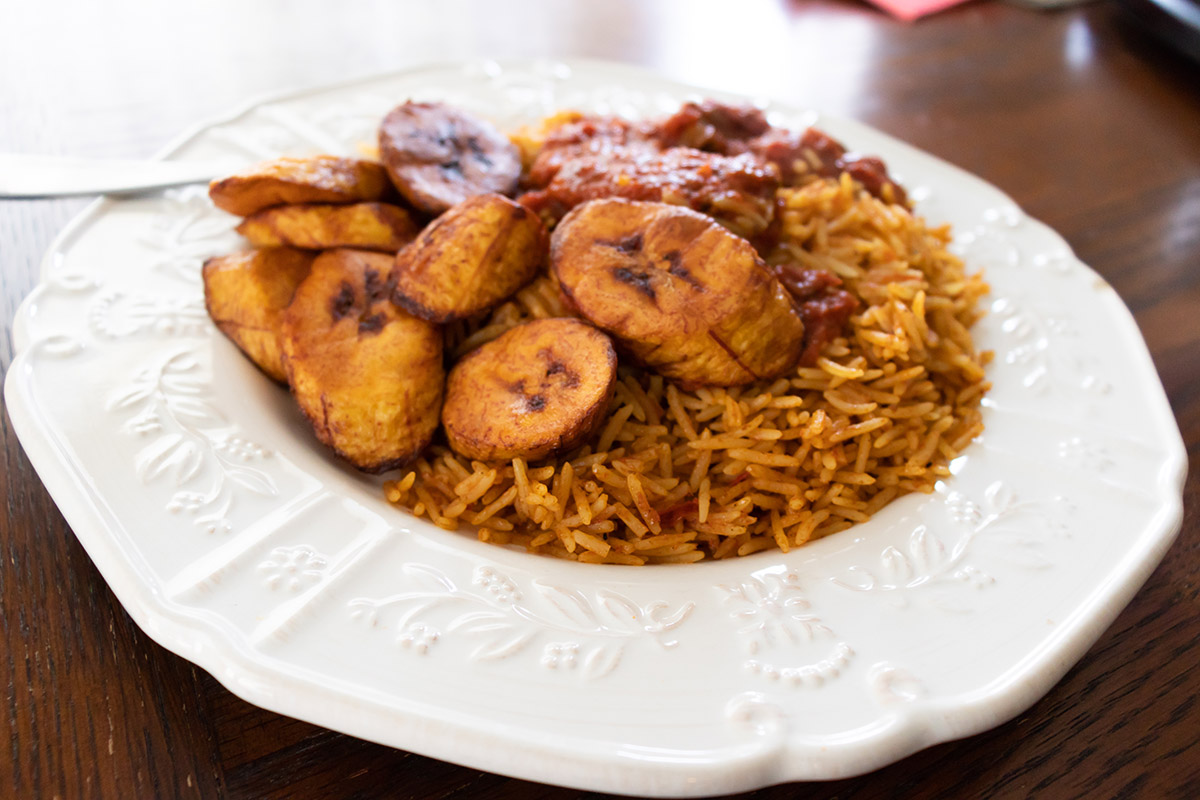
Armchair travel around the world!
Start your reading adventures with our FREE Reading Atlas.

- Around the World in 14 Books
- 7 Thrilling Book Series
- 6 Audiobooks That Are Like Theater For Your Ears



Food and drinks are some of the easiest ways — and the most fun— to vicariously experience another culture. When you add a great book to the mix, you've got the makings of a perfect evening. In Food+Fiction, we recommend a delicious read and a related recipe so you can try the taste of different destinations in your own kitchen.
This post is part of our Food+Fiction series.

The Nigeria-set novel Butter Honey Pig Bread is a glorious celebration of food, family, and forgiveness. It’s the story of three amazing women — twin sisters and their mother — who have been torn apart by the ravages of everyday life and desperately need to find their way back to each other.
One of the women, Taiye, is an avid cook, and Nigerian cuisine plays a starring role in the story. Pivotal scenes take place over steaming-hot stoves, at a wedding banquet, around the kitchen table — with favorite dishes and special ingredients expressing the love and longing that can’t be spoken in words. Even a chocolate cake meant to be a celebration is flavored with a touch of the bittersweet.
One night, Taiye promises to make Jollof rice. Even though she’s missing a key ingredient, she finds a way to make it work because ‘Everyone knows that you do not casually break promises of jollof rice and survive unscathed to tell the tale.’
In its most basic (and shockingly delicious) form, the dish is white rice — basmati or jasmine — that’s been simmered in a sauce made from tomatoes, red bell pepper, onions, and habanero chile. There may be herbs such as thyme and bay leaf involved; the version in Butter Honey Pig Bread uses palm oil and crayfish for extra umami.
What makes this rice so special — it’s a celebration dish with a place of honor on the table at weddings, funerals, and naming ceremonies — is that each grain seems to be super-saturated with flavor. It’s tender but not mushy, comforting but with a kick, spicy, yes, but also a bit sweet.
As with all cuisine worth its salt, each home cook puts their own spin on Jollof rice, and each country in West Africa has its own version. In Nigeria, it’s often cooked in cast-iron pots over an open fire, which gives it a slightly smokey flavor. Ghanaians add earthy spices like clove and nutmeg, while in Cameroon, you might find carrots and peas in the pot.
Jollof rice is pretty easy to make, but if you’d like to see it in action, here’s a very charming video. Yewande Komolafeis is a recipe writer who grew up in Lagos and now lives in New York. She selected 10 essential Nigerian recipes, for The New York Times; Jollof rice was, naturally, her top pick.
Our recipe sticks to the classic approach and, based on the recommendation of Yewande Komolafeis, adds a small amount of smoked paprika to recreate the flavor of open-fire cooking on the stovetop. We also used just one habanero, which gives it a kick but does not render it too hot; feel free to bring the heat by adding another chile or leave it out if you’re heat-shy.
Plantains are another staple of Nigerian cuisine, so we’ve recommended that you add fried plantains to your plate. After all, two luscious carbs are always better than one. Your plantains must be very ripe for the best caramelization, so the skins should be deep yellow with large black spots. The uglier they are on the outside, the more delicious they taste when fried. In Yoruba, sweet fried plantains are called dodo, and they’re usually deep-fried. We reduced the amount of oil to sauté the plantains; if you prefer to make it the traditional way, increase the amount of oil, so it’s about 1/2-inch deep in the pan (about 3 cups).

Serves 6-8. Total time 90 minutes.
Obe Ata:
Rice:
Prep the veggies. Remove the stem and seeds from the bell pepper and roughly chop. Peel and chop the onion, garlic, and ginger. Remove the stem from the habanero but keep the pepper whole. Place everything in the canister of a blender or food processor.
Blend the obe ata. Add the tomatoes and their juice to the blender. Purée until smooth. If the mixture needs a little more liquid to blend, add 1/4 cup of water. You should have about 3 cups of purée when you’re finished.
Cook the obe ata. Heat the 2 tablespoons oil in a medium saucepan over medium-high heat. Add the purée and cook until it begins to bubble. Reduce the heat to medium, and simmer, uncovered, until the liquid has reduced by about 1/3 of its volume. This should take about 20 minutes. (You want to have roughly 2 cups of liquid when it’s done.)
Sauté the rice. Place the 1/4 cup oil in a large saucepan or pot and heat over medium until it shimmers, about 3 minutes. Meanwhile, peel and thinly slice the onions and garlic. Add the onions to the pan and cook, stirring frequently, until soft, about 8-10 minutes. Remove half the onions to a plate and set aside. Add the garlic to the pan and cook until fragrant and translucent, about 2 minutes. Add the tomato paste, turmeric, and smoked paprika; cook until the tomato paste is a darker red color, stirring once in a while, about 2 minutes. Add the rice, thyme, bay leaf, salt, and pepper; stir to combine and cook 1-2 minutes.
Add the obe ata. Add the tomato sauce and stock to the pan. Bring to a boil, then reduce heat to low and simmer until the rice is tender, about 25-30 minutes. Turn off the heat and let the rice sit for 10-15 minutes; don’t lift the lid!
Big finish. Fluff the rice with a fork and stir in the reserved cooked onions. Taste and adjust seasonings, if necessary. Serve with fried plantains. (You might also want to cook a batch of this beef suya as a go-along.)

Serves 6-8. Total time 30 minutes.
Prep the plantains. Cut the ends off each plantain. Use a sharp knife to cut a slit along the length of the skin, being careful not to cut into the flesh of the plantain. Remove the skin. Cut each plantain into 1-inch pieces.
Marinate the onion. Peel and thinly slice the onion and place in a small bowl. Add the lime juice, red pepper flakes, and a pinch of salt. Toss to combine and set aside.
Cook the plantains. In a large skillet, heat the oil over medium-high heat, 3 minutes. Add pieces of plantain to the hot oil in a single layer and cook until nicely browned on all sides. Cook in batches — don’t crowd the pan! — removing browned plantains to a plate.
Big finish. When all the plantains are browned, toss them with the marinated onions while they’re still warm. Sprinkle with the lime zest and salt. Serve immediately.
In the kitchen, Taiye checked on the browned pieces of curried chicken roasting on a tray in the oven. Realizing she’d forgotten to stop by the Falomo market to buy tinned tomatoes, she decided to make do with whatever was in the cupboard: maybe palm oil, maybe crayfish, maybe some efirin. Perfect for native jollof, actually… [T]his is how you make native jollof rice, or, in Efk, iwuk edesi. Because you forgot to buy tinned tomatoes, but you promised your family jollof rice. Everyone knows that you do not casually break promises of jollof rice and survive unscathed to tell the tale. You will need two cups of rice, preferably long-grain white rice, but really, any type of rice will do. You will also need a quarter cup of palm oil, some smoked fish - Eja Osan would be your best bet — one large onion, a half cup of dried prawns, ground peppers, two tablespoons of ground, dried crayfish, one tablespoon of pureed tomato, a small bunch of chopped efrin, half a tablespoon of salt, and a cup of beef stock or two bouillon cubes. — Francesca Ekwuyasi
This glorious novel is a celebration of food, family, and forgiveness. It’s the story of three extraordinary women, bound by love, who lose each other in the mess of life and then find their way back. The story begins when we meet Kambirinachi. She believes that she’s an Ogbanje, a magical being tortures its mother by being born and dying in childhood, over and over again. One day, Kamrinachi decides to ignore the voices of her ancestral kin and chooses to live. That fateful decision drives and shapes the rest of her days. {more}
This family saga (368 pages) was published in November of 2020 by Arsenal Pulp Press. The book takes you to Lagos, Nigeria. Melissa read Butter Honey Pig Bread and loved it; it wouldn't be on our site if she didn't recommend it.
Bookshop.org is an online bookstore with a mission to financially support independent bookstores and give back to the book community.
Top image courtesy of i_am_zews/Shutterstock.
Want to keep up with our book-related adventures? Sign up for our newsletter!
Can you help us? If you like this article, share it your friends!
Strong Sense of Place is a website and podcast dedicated to literary travel and books we love. Reading good books increases empathy. Empathy is good for all of us and the amazing world we inhabit.
Strong Sense of Place is a listener-supported podcast. If you like the work we do, you can help make it happen by joining our Patreon! That'll unlock bonus content for you, too — including Mel's secret book reviews and Dave's behind-the-scenes notes for the latest Two Truths and a Lie.
Join our Substack to get our FREE newsletter with podcast updates and behind-the-scenes info — and join in fun chats about books and travel with other lovely readers.

We'll share enough detail to help you decide if a book is for you, but we'll never ruin plot twists or give away the ending.
Content on this site is ©2025 by Smudge Publishing, unless otherwise noted. Peace be with you, person who reads the small type.